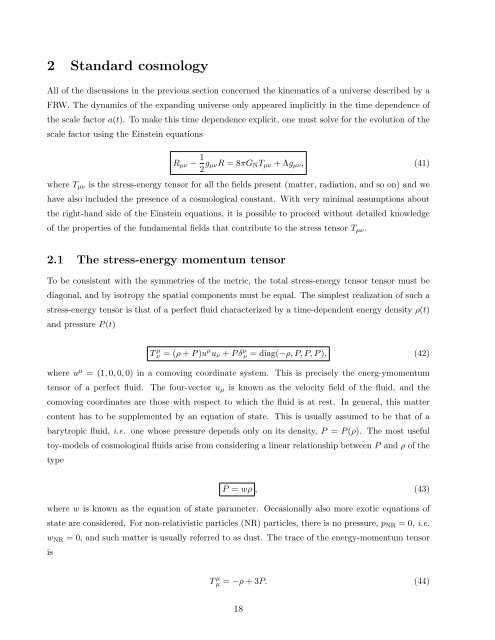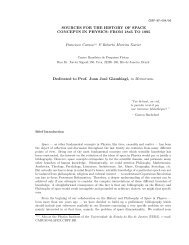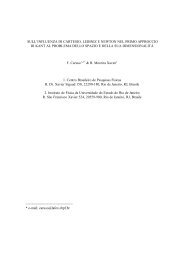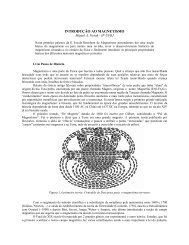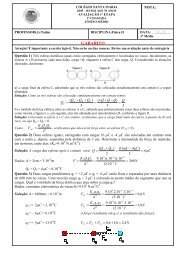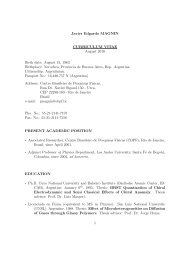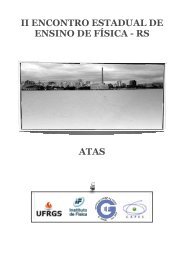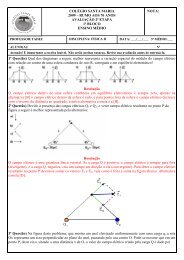Primordial non-Gaussianity in the cosmological perturbations - CBPF
Primordial non-Gaussianity in the cosmological perturbations - CBPF
Primordial non-Gaussianity in the cosmological perturbations - CBPF
Create successful ePaper yourself
Turn your PDF publications into a flip-book with our unique Google optimized e-Paper software.
2 Standard cosmology<br />
All of <strong>the</strong> discussions <strong>in</strong> <strong>the</strong> previous section concerned <strong>the</strong> k<strong>in</strong>ematics of a universe described by a<br />
FRW. The dynamics of <strong>the</strong> expand<strong>in</strong>g universe only appeared implicitly <strong>in</strong> <strong>the</strong> time dependence of<br />
<strong>the</strong> scale factor a(t). To make this time dependence explicit, one must solve for <strong>the</strong> evolution of <strong>the</strong><br />
scale factor us<strong>in</strong>g <strong>the</strong> E<strong>in</strong>ste<strong>in</strong> equations<br />
Rµν − 1<br />
2 gµνR = 8πGNTµν + Λgµν, (41)<br />
where Tµν is <strong>the</strong> stress-energy tensor for all <strong>the</strong> fields present (matter, radiation, and so on) and we<br />
have also <strong>in</strong>cluded <strong>the</strong> presence of a <strong>cosmological</strong> constant. With very m<strong>in</strong>imal assumptions about<br />
<strong>the</strong> right-hand side of <strong>the</strong> E<strong>in</strong>ste<strong>in</strong> equations, it is possible to proceed without detailed knowledge<br />
of <strong>the</strong> properties of <strong>the</strong> fundamental fields that contribute to <strong>the</strong> stress tensor Tµν.<br />
2.1 The stress-energy momentum tensor<br />
To be consistent with <strong>the</strong> symmetries of <strong>the</strong> metric, <strong>the</strong> total stress-energy tensor tensor must be<br />
diagonal, and by isotropy <strong>the</strong> spatial components must be equal. The simplest realization of such a<br />
stress-energy tensor is that of a perfect fluid characterized by a time-dependent energy density ρ(t)<br />
and pressure P (t)<br />
T µ ν = (ρ + P )u µ uν + P δ µ ν = diag(−ρ, P, P, P ), (42)<br />
where u µ = (1, 0, 0, 0) <strong>in</strong> a comov<strong>in</strong>g coord<strong>in</strong>ate system. This is precisely <strong>the</strong> energ-ymomentum<br />
tensor of a perfect fluid. The four-vector uµ is known as <strong>the</strong> velocity field of <strong>the</strong> fluid, and <strong>the</strong><br />
comov<strong>in</strong>g coord<strong>in</strong>ates are those with respect to which <strong>the</strong> fluid is at rest. In general, this matter<br />
content has to be supplemented by an equation of state. This is usually assumed to be that of a<br />
barytropic fluid, i.e. one whose pressure depends only on its density, P = P (ρ). The most useful<br />
toy-models of <strong>cosmological</strong> fluids arise from consider<strong>in</strong>g a l<strong>in</strong>ear relationship between P and ρ of <strong>the</strong><br />
type<br />
P = wρ , (43)<br />
where w is known as <strong>the</strong> equation of state parameter. Occasionally also more exotic equations of<br />
state are considered. For <strong>non</strong>-relativistic particles (NR) particles, <strong>the</strong>re is no pressure, pNR = 0, i.e.<br />
wNR = 0, and such matter is usually referred to as dust. The trace of <strong>the</strong> energy-momentum tensor<br />
is<br />
T µ µ = −ρ + 3P. (44)<br />
18


